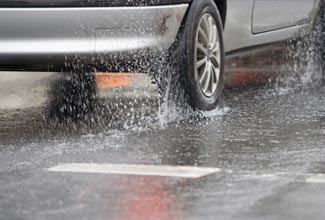Defensive driving instructors will tell you that hydroplaning is what happens when the tread on your tires cannot channel all the rain-water out from under your tires – or, from under each patch of tire that is supposed to be resting on the road and providing you with traction. When hydroplaning, those tire patches are riding on a layer of water instead of pavement. Many different factors can affect the speed at which a tire will hydroplane, such as water depth, speed, the weight of the vehicle, the width of the tire, depth of tread, and tread pattern, but all tires will hydroplane with the right combination of speed and water depth. Most often, you hydroplane when your fast-moving vehicle hits a deep puddle. The steering wheel jerks suddenly and the vehicle veers toward the puddle. It’s a good idea to slow down before hitting a puddle. Other times, when rain is pouring down in sheets, there can be enough water on the roadway to cause a vehicle to hydroplane (without apparent puddles).
An attentive defensive driving driver should recognize the potential for hydroplaning and will have slowed enough to prevent the problem. If not, the first indication will be when the vehicle pulls suddenly in deeper water and begins to slide out of control. Or, you may be approaching a curve and discover that your vehicle doesn’t respond to your steering input. On a straight stretch, a slight “wiggle” of the steering wheel can give you immediate information on whether you are hydroplaning or not. I wouldn’t try this on a curve, however. Another possibility is to check out your tire tracks in the rear-view mirror (if you can clearly see them). You should be able to see distinct tracks on the wet surface behind you, and even see your tread pattern on the pavement for a few seconds before water covers it again. Remember that not hydroplaning means your tread is removing all of the water that gets between your tires and the road surface (channeling it away). If you cannot see your tracks and tread pattern distinctly on the road surface behind you, slow down, because you may be waterskiing on four wheels!
If you find yourself hydroplaning, use your Defensive driving skills, do not touch the brakes. Slow down by smoothly lifting your foot from the accelerator, engage your clutch if you are driving a standard shift vehicle, and let it coast down to the point where the hydroplaning stops. Some experts advise shifting an automatic transmission into neutral while you slow but I do not recommend this (for the same reason I wouldn’t put my transmission in neutral on a downgrade). Remember that smoothness is very important — you don’t want to make any sudden moves. You will not be able to steer while the vehicle is hydroplaning.
Defensive driving skills can prevent hydroplaning. Keep good tires on your vehicle. Keep your speed down in the rain (slow by at least 1/3) and if you are following another vehicle, try to drive in their tire tracks — let their tires displace some of the water so yours don’t have to work so hard. If you do get a ticket take our defensive driving course 2passdd.com

